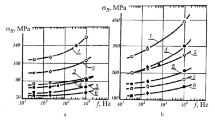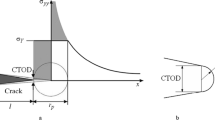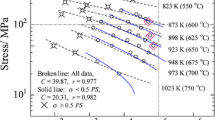Conclusions
-
1.
The resistance of the sample material to thermal cycling for a variable form of the cycle (different holding periods at the maximum temperatures) is determined by a combination of accumulated long-term static (creep) and low-frequency fatigue damage. With increasing duration of the cycle and falling number of cycles to failure, the first of these contributions to the total damage increases.
-
2.
As a characteristic of the resistance to thermal-fatigue failure it is proposed to use the relationship between the period of the cycle and the overall time required for rupture to occur, the parameters being the maximum temperature of the cycle and the amplitude of the cyclic (fatigue) deformation (strain). In this case the curves corresponding to the limiting states are arranged on the diagram in different ways, reflecting various degrees of influence of the holding periods on the conditions of thermal cycling.
-
3.
As a characteristic of the fatigue effect we may use the coefficient
$$\lambda = 1 - \frac{{1g(\tau _c N)}}{{1g\tau _r }},$$determined experimentally as a function of τc and depending little on the spread of the deformation Δɛ.
-
4.
With diminishing duration of the holding period, or on passing to a form of cycle with a continuous cyclic variation of the strain, the effect of fatigue damage becomes greatest; for the highest frequencies of thermal-fatigue strain, the quantity λ reaches values of about 0.8 to 0.9. On passing to processes with very long holding periods, the rupture conditions approach those corresponding to long-term static (creep) failure and λ→0.
-
5.
On the basis of our analysis of the rupture conditions associated with thermal cycling and the corresponding experimental data, we have obtained an expression for determining the reserve of thermocyclic strength in particular samples; this expression enables us to determine the reserve with respect to stresses if we know the reserve with respect to creep strength determined from the conditions of long-term static (creep) resistance, and if we also know the corresponding value of the coefficient λ, which is characteristic of the particular material under consideration at the maximum temperature of the cycle.
Similar content being viewed by others
Literature Cited
R. A. Dul'nev, “Resistance of heat-resistant alloys to thermal fatigue in relation to the form of the thermal cycle,” in: Heat Resistance of Materials and Structural Parts [in Russian], No. IV, Naukova Dumka, Kiev (1967).
L. Coffin, Trans. ASME,78, No. 3 (1956).
S. V. Serensen and P. I. Kotov, Zavod. Lab.,28, No. 10 (1962).
Yu. F. Balandin, Thermal Fatigue of Metals in Marine Power Engineering [in Russian], Sudostroenie, Leningrad (1967).
E. Glenny and T. A. Taylor, J. Inst. Met., July (1960).
S. S. Manson, Symposium at Ann Arbor, Mich., June 27–28, 1952, Univ. of Michigan Press.
S. V. Serensen, “Resistance criteria of materials subjected to nonstationary loading at high temperatures,” in: Heat Resistance of Materials and Structural Parts [in Russian], No. IV, Naukova Dumka, Kiev (1967).
É. Melan and H. Parkus, Thermoelastic Stresses Due to Stationary Temperature Fields [Russian translation], Fizmatgiz, Moscow (1958).
B. F. Shorr, Izv. Akad. Nauk SSSR, Otd. Tekh. Nauk, Mekhanika i Mashinostroenie, No. 6 (1960).
Additional information
Central Scientific Research Institute of Aircraft Engines, Moscow. Translated from Problemy Prochnosti, No. 1, pp. 12–19, July, 1969.
Rights and permissions
About this article
Cite this article
Serensen, S.V., Dul'nev, R.A. & Bychkov, N.A. Estimating rupture resistance in thermal fatigue. Strength Mater 1, 9–15 (1969). https://doi.org/10.1007/BF01675427
Received:
Issue Date:
DOI: https://doi.org/10.1007/BF01675427




